October 27, 2010
Cruising Through Portugal
Press HERE to see a slideshow
of Portugal.
Betty in Viana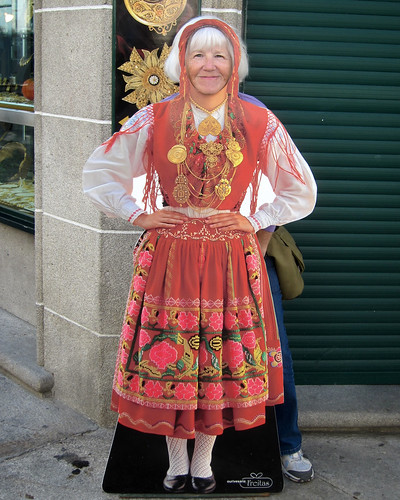 |
Bruce and Rety Fuller 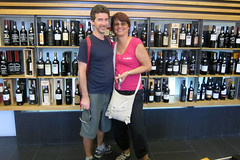 |
Castle in Obidos  |
Rooftops of Tavira 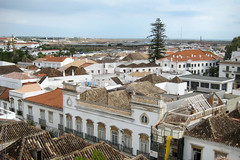 |
On Monday, 18 of October, we drove south into Portugal. We were headed toward Porto. We first stopped in the town of Viana do Castelo, where we spent a few hours looking around and eating lunch. Then we continued south to Povoa de Varzim, where we found rest and friendship with our couch-surfing hosts, Bruce and Rety.
Visiting Bruce and Rety Fuller was a real joy. Betty and Rety really clicked with similar slants on life and politics. We had a great evening getting to know them. On Tuesday they accompanied us into Porto. Porto is the home of the famous Port Wine. The best Port wine makers in the world have vineyards in the nearby Douro River valley, where the rocky soil and 120 degree summer days produce grapes for Port wine. We visited many monuments in the city. We walked along the Douro River. We had a light lunch and we visited two wineries to taste their port. Betty and I liked the Port wine. We finally returned on the train to Povoa.
On Wednesday, we spent all the day driving south. We had so much ground to cover that we used the toll roads for much of the journey. The total cost for less than 300 miles of road travel was more than $50. Along the way we stopped in a couple of interesting towns. First there was Obidos. Obidos is a lovely, walled, medieval town with a castle and everything else one might expect. After a couple of hours, we passed through Sintra. This is an even more fantastic city. Unfortunately, we only explored the city by car. We drove onto Lisbon. We wanted to see the waterfront and some of the old city. Again we only saw it by car. There was no parking, even in the city lots - which were full. In the late afternoon, we again proceded south to our ultimate destination, Vilamoura, which is near Faro. Our couchsurfing host Miguel was by far the most generous of our hosts. We could not pay for anything. His condo was in the middle of a golf course that is surrounded by other golf courses. We do not play, so it was not quite paradise for us. Still, it was a beautiful area. Southern Portugal is a favorite vacation spot for tourists, especially the Brits. Even at this time of year, we found tourist throughout this region.
On Thursday we traveled to the two seaside resort towns of Lagos and Sagres. Sagres was nearly a complete waste of time. Lagos is a lovely old town with all of its commerce based on the hundreds of tourists that walk through its streets everyday.
On Friday we traveled to Tivera, the loveliest town that we have seen in the south. We tried to see the main monuments and churches. We tried to visit Faro, which was much larger than I had imagined. We decided to skip the visit when we could not find parking. Some sort of fair had taken over the major parking area for the city. Instead we went to Vilamoura to enjoy an afternoon of drinking beer at the marina.
On Saturday we set off for Seville, and within a couple of hours we were back in Spain.
Sunset on the Beach at Povoa de Varzim
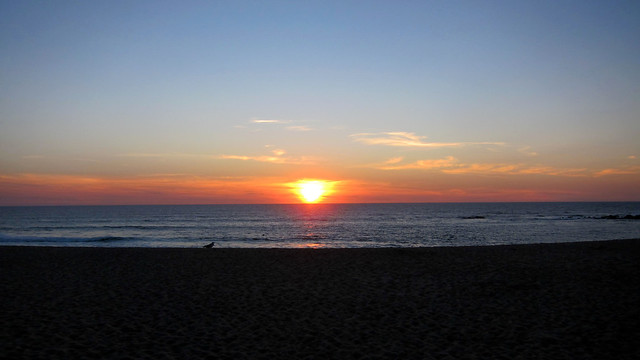
October 15, 2010
Northern Spain
Press HERE to see a slideshow
of Northern Spain.
The Guggenheim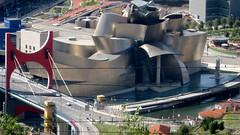 |
Reflection in the Tulip 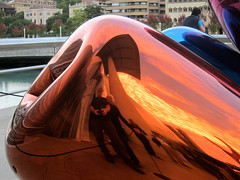 |
The Burgos Cathedral 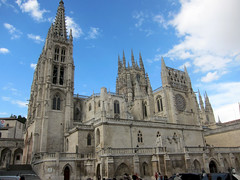 |
In the Burgos Cathedral 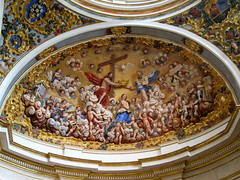 |
Bishop's Palace by Guadi 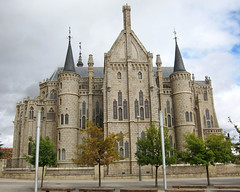 |
Statehouse of Galacia 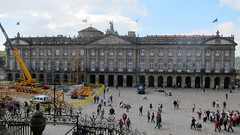 | Park and Plaza in Ponteverdra  |
We drove south and crossed into Spain on Monday. Then we drove west along the north coastline of the Bay of Biscay. We stopped to buy gas. I never thought that I would be glad about paying $5.70 per gallon, but that was a lot better than the $7.00 per gallon cost in the rest of Northwestern Europe. We stopped in Lequeitio, a beautiful little fishing village, for a short rest and a bite to eat and some local hard cider. We arrived at the home of Casey and Asier, our couch-surfing hosts, about 6:30. It was 8:30 before they got home from work. We caught them at their busiest time of the year, and they were working long hard hours. We were glad that they took us in during this busy time, but felt sorry that they had to be gone so late everyday.
On Tuesday, we explored the city. Asier guided us to a metro station were we could park all day for less than one dollar. Given the hectic freeway system that surrounds the city, we were surprised at how quiet and calm the city center was. The metro fares were fairly cheap, too. The center of Bilbao is a beautiful, clean place. Asier had helped us figure out a good walking tour. We saw all of the old city. We walked along the river, where we saw the town hall. Then we took the funicular up the side of the mountain and got a fantastic overview of the city. Especially notable from these heights was our view of the Guggenheim.
Late in the afternoon we drove back to the coast to see some wonderful views near Bermeo. We saw a light house near Cabo Matxitxako. And we saw Bakio, a small resort city with fabulous surfing waves and lots of surfers riding the waves.
On Wednesday we started the day by visiting the Guggenheim Museum. Frank Geary designed the museum. I am no lover of his style, but it is a spectacular sight. The museum is dedicated to modern art. The paintings in the museum were not to my taste, but the sculpture was fabulous. The artists of the main shows were Jeff Koons, Richard Serra and Anish Kapoor. Please take a look my the photos to get a sense of their works. Koons’ Tulips were fantastic. The gigantic pieces of Serra's two-inch thick steel were overwhelming. We loved the works of Koons and Serra. Kapoor’s pieces were a mixed bag for me; I loved some and hated others. We left about one in the afternoon.
We were going to go to Santander, but the we did not find the city inviting, so we turned south toward Burgos. We got as far as the small medieval town of Aguilar de Campoo. We found a small hotel, that I thought was too expensive, but hotels in Spain are very expensive. We have been lucky enough to have avoided staying in hotels. The floor for hotels is about $54 per night and the common prices are $100 to $200 per night. In Spain this does not include breakfast. They often charge by the person - not the room. Single travelers might get by for as little as $40 in a hotel or $28 in a hostel.
On Thursday we spent the morning climbing to the ruins of an old castle, visiting an old monastery and an old Roman wall. Then we set out on the road. We visited Olleros de Pisuerga, a small town, where the church was carved into a rock wall. Then it was on to another monastery at Santa Maria de Mave. Finally we drove to Burgos, where we began to explore the city. We saw the outside of the cathedral and several monasteries and churches. At six in the evening, we met with Rodrigo, our couch-surfing host. He is an extremely kind and soft-spoken man. He is a doctor and works at the local hospital. We went to a grocery store and got the fixings for a great spaghetti diner. We learned a lot about the local area and we used his recommendations for places to visit on Friday.
On Friday we returned to the Cathedral of Burgos. We paid our entrance fee for the museum. It is a great old church with lots of wonderful chapels. We had visited the two working and free chapels on Thursday. The rest of them and the nave where extremely impressive. It was the greatest cathedral so far. Another great thing is that we found another pair of my ancestors buried there. Who were they? Rodrigo Diaz de Vivar and his wife Ximene. Rodrigo was also known as El Cid, who led the struggle against the Spanish Moors.
Then we drove out into the countryside. We visited the town of Lerma with its stunning castle for the Duke of Lerma and its monasteries. We also visited Santo Domingo de Silos before returning to Burgos.
On Saturday we drove to Leon. It was raining off and on along the way and the streets were wet when we arrived. The main walking street was lined with flower boxes just below the the second story windows. It is a beautiful city. We saw a mansion designed by Gaudi and we visited the Guzmane house. We also walked by or into many old churches and monasteries. One Church was built some 1100 yeas ago in the 10th century. But the shining star of the city's architecture is its cathedral, where we spent an hour looking around. Our next stop was the nearby town of Astorga. Astorga was on the way to our next destination and we had heard of two of its magnificent buildings: its cathedral and its bishop’s palace. We could not get into the cathedral but its ancient exterior was great. We also saw the bishop’s palace, which was designed by Gaudi. The design was wonderful and seemed like it came from a fairy tale.
We pushed on to Lugo, some two hours away. We expected to find a hotel room here, but unbeknownst to us there was a huge festival in progress and we arrived as the concert goers by the thousands were also arriving. To say the least there was no room at the inn. So we headed in the direction of Santiago de Compostela. I knew of a rural inn and we headed there. They, too, were full but a recommendation led us to a small in near Arzua.
We continued on to Santiago de Compostela on Sunday. We had discovered that Columbus Day is a huge national holiday in Spain. Hundreds of thousands of Spaniards took long weekends to travel and enjoy a few days with their families or to see a bit of their country. In Santiago de Compostela there were thousands of visitors crowding the streets on Sunday. Added to the the weekend holidayers a couple thousand pilgrims arrive in the city everyday. Yes, I said pilgrims. Starting in France we saw the signs on the paths that lead to Santiago. The signs are icons of a sea shell. I have posted several pictures of the signs on my Flickr photostream. The pilgrims walk for one hundred to a thousand kilometers and when they arrive ALL their sins are forgiven by an edict of the pope. In any case, we were overwhelmed by all the people in Santiago. We pushed our way through the crowds to tourist office, only to queue up for 20 minutes to get maps and ask questions about accommodations. We did find a nice hotel with vacancies one mile from the city center, cost for two nights with breakfast was $155 and this was inexpensive. We spent some time exploring the center but then checked in to our hotel, Hotel Capital Galicia.
On Monday, we walked to the center taking our time to see many old buildings including churches, markets, a Roman arched gate, schools, etc. We took a long leisurely lunch. Then we continued are exploration. We entered the cathedral. The rehabilitation in progress was extremely distracting, scaffolding everywhere. Still we saw a spectacular nave. The bones of Saint James are buried in the church. In the late afternoon we returned to our hotel ready to move on to our last destination in northern Spain.
On Tuesday, Columbus Day, we drove down the coast. Our ultimate goal was the village Bueu just past Ponteverde. We drove slowly through many small and beautiful villages. We stopped at lunchtime on an island to have tiny shrimp, two fried sardines and a plate full of clams. We continued on to Ponteverde, then south to Bueu. We tried to find the house of our couchsurfing host, but to no avail. So we went a few miles away to a wonderful beach. We hung out for a few hours. Later, we tried to call our host. He was not answering and this was our first couchsurfing snafu. We are not sure what went wrong, but it became clear that we and our host we were not on the same wavelength. Despite the problem, we did have a bit luck. We found a hotel that cost only $40 per night.
On Wednesday we spent the afternoon hiking through the old part of Ponteverde. It was a much smaller town than most we have visited. We visited churches, a museum and a cathedral. We also set up another host to visit on Friday. We wanted to have a couple of quiet days before going to Portugal.
The next report will come from Portugal.
Beach Near Bueu
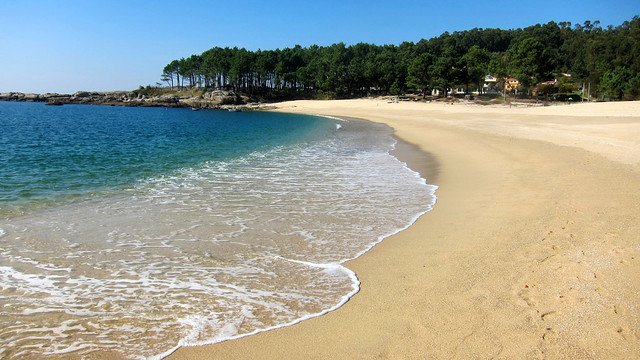
October 03, 2010
The Dordogne in Aquitaine, France
Press HERE to see a slideshow
of our days in the Dordogne.
Gerard and Karin Muguet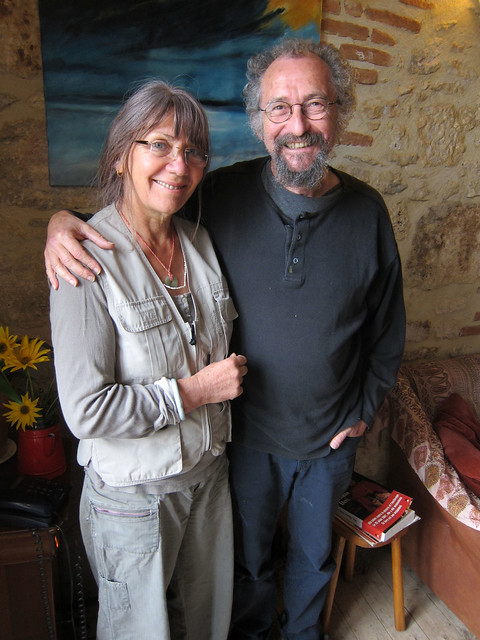 |
Mathis, Jean-Marc, Peran and Juliette 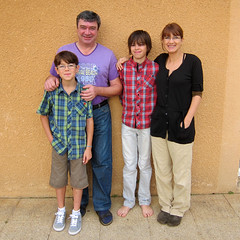 |
On Saturday the 25th of September, I drove all day south to a small village in the Dordogne region of the Aquitaine, France. We did not take the many of the motorways, because most of them are toll roads with exorbitant tolls of about 16 cents (USD) per mile. We noted that all the southern European countries have toll roads. Something hard for us to understand with gas costing about $7 per gallon. The drive was hectic as our GPS was not always working and the traffic in Paris was horrible.
We went to our couchsurfing hosts in Montignac. They were Gerard and Karin Muguet. They were a fascinating couple. Both are about our age, they are Tibetan Buddhists. They are vegetarians. He is an extremely accomplish artist and graphic designer. We got a chance to meet their granddaughter Kim on the night of our arrival. They were very helpful in helping to plan our daily excursions in the the Dordogne. We shared many a meal with them and we drank a box of the excellent Bergerac wine with them.
Betty has long wanted to visit the most beautiful villages in France. During our visit to this region we saw more than a dozen midieval villages. Most of them were built between the year 1000 and 1300 with various improvements after that. It was interesting to learn the history of the area, especially the role of the English. They controlled the area for hundreds of years and fought an ongoing war with the French over it. After the French finally won out, religous wars ensued between the protestants and catholics. Despite all the wars, people here seemed to prosper; probably due to the rich agricultural land and the numerous rivers. You will have to look at all the photos that I posted at my Flickr photostream to get a sense of how beautiful they were. I will try to name them now: St. Amand de Coly, St. Genie, Sarlat, Domme, La Rouque-Gageac, Beynac, Saint Leon-sur-Vezere, Limeuil, Belves, Monpazier, Fanlac, Souillac, Cadouin, Beaumont du Perigord, Bergerac, Perigueux, Bourdeilles, Brantome and Saint Jean de Cole.
We moved to a suburb of Perigueux on Thursday. We stayed with another wonderful couchsurfing host family, Jean-Marc and Juliette Lagniel. They too are graphic artists. They have two boys: Peran (age 13) and Mathis (age 11). They were wonderful to us. We shared three wonderful meals with them, the last being the typical Aquitaine duck with chestnuts.
Today we drove to Biarritz on the southwest coast of France. The wind was blowing hard. Still it is a beautiful place. There were many people surfing in the thunderous waves.
Tomorrow we will check out two more towns: Bayonne and St. Jean de Luz. You will be able to find photos in the Aquitaine set on my flickr photostream.
Tomorrow night we will be in the Spain, somewhere in or near Bilbao. I will try to post another entry in a week or so.
Chateau de Beynac
